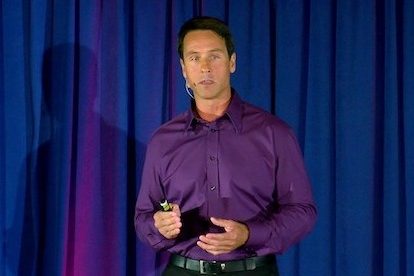Did you know that the concept of teaching by lecture was, at one time, required because providing texts to students was too expensive3? Before the printing press became an affordable option, manuscripts were copied one-by-one and by hand. So, to get around the need for scribes to create textbooks, the guru would stand up and lecture while students took their own notes. This method emerged the world over, going back millennia from Asia, through the Middle East, and yes, the Ancient Greeks and Europeans5. But by the time the printing press came around, the cultural expectation of a guru standing in front of a group of students and talking for the purpose of transmitting knowledge was so deeply ingrained, that it continued, and continues to this day.
This tradition probably goes back tens of thousands of years, and the modern lecture was a required adaptation from the storytelling traditions of prehistoric hunter-gatherers learning around a campfire. Throughout our human evolution, storytelling transmitted tribal history and important survival information. It was integral to the building and maintaining of tribal culture. But when the storytelling that was encoded with knowledge changed into the mere lecturing of pure knowledge, like advanced mathematics and chemistry, it ceased to be easily absorbed by those trying to learn. The diminished effectiveness of lecturing on learning can be blamed on many factors – all of which are either based on psychological or neuroscientific characteristics of the individual.4 Not surprisingly, any team building that actually did result from this form of instruction was accidental and more likely the result of the shared experience of persevering through the lectures and the exams that followed.
The adaptation of the hunter-gatherer storytelling tradition into academic lectures is not brain-based. Interestingly though, lectures still exist in the classroom because of the brain – which I will explain later. One unavoidable fact in our modern business world is that learners need to work together efficiently and effectively, and they require accurate information to accomplish that. Proper brain-based teaching has stood up to scientific rigor as having significant advantages over the traditional lecture that translates into real-world results. 1, 2, 3
See, brain-based teaching is learner-centered instead of simply instructor-based or knowledge-based. Brain-based instruction focuses on where the learner IS rather than where they are expected to be based on age, career path, socioeconomic or cultural status, or communication style. Basically, it does not assume that everyone in the group is in the same place to understand and retain the information.
Creating a true brain-based team learning environment is very challenging. Many trainers claim to do “brain-based” teaching, but in the end, they are only leveraging the brain to sell their courses and keep clients paying them. They accomplish this by using old-school activities with an added feel-good factor.
The Feel-Good Factor
The feel-good factor is nothing more or less than trainees leaving a course and feeling good. When a class is designed in a way that dopamine and serotonin release in the learners’ brains, they “feel good.”
Training companies leverage this feel-good factor to get positive feedback from employees after training is completed, so they can gain more business. In order to do this, they need to accomplish three things:
- The trainees need to walk away from the class feeling smarter, whether that is true or not.
- The trainer must be liked by the class. This is why these courses feature attractive, charismatic instructors.
- The trainees have to enjoy the class. This is why these courses usually include fun-based activities.
Now, whether these programs are useful or not is beside the point, what is true is that many times, the only brain science in the course is the one used to make sure the trainer maintains the client. Let me explain …
Brain-Based Leadership Training
Imagine that I am a trainer selling “Brain-Based” leadership training to an HR department. If I talk about neuroscience, whether or not it’s factual information, it seems like I’m using brain-based strategies.
Consider how many trainers focus on “right-brain, left-brain”, which neuroscience has proven to be a myth when it comes to identifying personality characteristics that impact behavior. Most trainees and most HR folks will not realize that it is not brain-based training. If HR was extremely knowledgeable about brain-based leadership training, they wouldn’t outsource their training in the first place. As a result, they don’t realize the costly training they purchased was not actually using neuroscience-tested strategies at all.
Still, trainees and HR like these types of training courses because they feel like they’ve learned something, they are given a scapegoat for their less-admirable qualities and they are given praise for their unique strengths. The information is readily absorbed because myths like the left-brained/right-brained myth have been popular in culture for so long that neural pathways have already been laid down for them. It’s easier to engrain existing myths more fully than to completely replace the myths with genuine neuroscience. This is the exact same reason we continue to teach through traditional lectures as we had done before books were cheap. It feels correct because it’s how it has been done.
Learners have a pre-existing mental anchor making these types of training courses feel believable. They feel that they could even get a status boost by teaching the material to others. They enjoy the training courses and are likely to give very positive feedback, but the truth is that the trainer leveraged a “popular story” to create a false narrative that had a real impact on the person’s esteem, which activated the brain’s reward circuitry. So of course, they enjoyed it – but they learned nothing “true” about the brain. Meanwhile, the feedback suggests to HR that this trainer is “good” and should be awarded future programs.
Here’s another example. Many leadership trainers sell “brain-based” outdoor team activities. Sometimes the courses take place high in trees to have a bigger emotional impact. What happens here? Well, the students share an experience in which they have to support each other in a situation in which some of them will struggle – maybe because they are afraid of heights, or maybe because the challenge requires them to all work together to solve a problem. Then, the trainer explains that the brain has a harder time under stress, something all of us have already been primed to understand. The trainer demonstrates how working together is the way to solve problems. The trainer likely makes claims that stress reduces creativity and problem-solving ability, which isn’t totally true. Incidentally, the brain thrives on a bit of stress, it just has a sweet spot.
Humans are social animals and our brains are able to record memories very quickly in strong emotional times such as the outdoor leadership training courses held high in the trees. So, the participants have created a memorable social emotional memory that, again, activates their brain’s reward circuitry. Was there education in the course? Maybe a little, but ultimately the team feels smarter, had some social bonding, and got their dopamine and serotonin hits, so they give positive reviews of the course – and the training company keeps their job..
But what brain-based functional education did these trainees gain from these leadership courses?
In both training situations, very little brain-based material or skills were taught that could be useful in a working environment. Essentially, the company paid for a somewhat fun, paid vacation for their leaders-in-training. The trainees feel smarter, without gaining useful knowledge though. In both of these training situations, the trainer simply leveraged the brain for their own benefit. They get repeat business, so the trainer continues this ineffective style of leadership training.
True Brain-Based Leadership Training
When a group has true brain-based training, they actually learn about how the brain works and how that information is actionable today, tomorrow, and onwards. The training helps them understand what they can do to improve team learning, help the team work together better, improve creativity, and increase effectiveness and efficiency. It is done by turning complicated learning into stories, by leveraging emotions, by making the knowledge actionable immediately, by making it personal, and by making the learning a social experience. And of course, effective courses follow-up with learning reinforcement, ongoing dialogue and feedback forums so that the learning can remain relevant and behaviors can continue to adapt based on the feedback.
Brain-Based Team Building
So, how could brain-based team building work? Well, at the Academy of Brain-based Leadership, we created a personalized course. Our course includes individual assessments that allow each team member to understand their brain-based triggers. We use stories and analogies to explain and express the differences between these different brain-based triggers. We brought back the campfire advantages. We made our training courses a social experience by allowing the team to see their differences and share and discuss the issues that arise based on those differences, because this allows them to generate insights and strategies to work together with the individuals’ brains in mind. And of course, we provide simple, practical tools that allow the team to implement the learning, facilitate ongoing dialogue and continue to gather feedback over time. This way the learning remains relevant and actionable so that managers and teams can adjust strategies for maximum effect.
If you would like to know more about the S.A.F.E.T.Y.™ Team training program, the S.A.F.E.T.Y.™ assessment, and even our trainer certification program, you can find out more at brainleadership.com.
- Tafti, Mahnaz & Kadkhodaie, Mahbobeh. (2016). The Effects of Brain-Based Training on the Learning and Retention of Life Skills in Adolescents. 10. 140-144.
- Duman, Bilal. “The Effects of Brain-Based Learning on the Academic Achievement of Students with Different Learning Styles.” Educational Sciences: Theory and Practice 10.4 (2010): 2077-2103.
- Bellah, Kimberly A., et al. “Brain-based learning: A synthesis of research.” NACTA Journal (2008): 15-22.
- Degen, Ronald. “Brain-based learning: The neurological findings about the human brain that every teacher should know to be effective.” Amity Global Business Review 9.1 (2014): 15-23.
- In praise of teachers-4,000 years of preparing the next generation. AntiquityNOW. (2014, October 9). Retrieved November 28, 2022, from https://antiquitynow.org/2014/10/09/in-praise-of-teachers-4000-years-of-preparing-the-next-generation/













